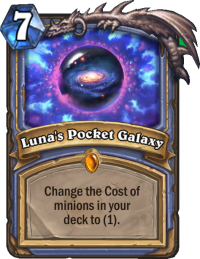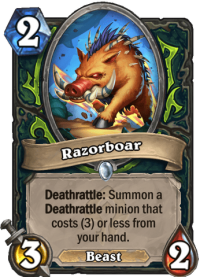Ten days in, the supposedly spicy patch hasn’t brought along a whole lot of changes in the Standard metagame, and it’s the ultimate irony that the age-old buffs to Libram cards are a big part of Paladin’s continued domination in the current environment. So how do Team 5’s buffing efforts stack up to scrutiny and what changed since the days when they were adamantly against them? The game is no longer the same, and neither are their attitudes to design.
A Trip Down Memory Lane
The veterans among you may remember an interesting bit of video back-and-forth between Kripp and Ben Brode all the way back in 2015. The skipperino extraordinairo has proposed that “bad cards do not need to exist” and suggested a set of buffs to laughably unplayable cards like Silverback Patriarch. It was such a discussion starter that Hearthstone’s lead designer took the time to film a response to it.
The basics of this discussion have been well-documented in other card games and other facets of game design. Not every card can be good as there is always going to be a top ten regardless of the baseline power level; bad cards can serve as teaching tools or cater to players who are more interested in a fancy combo rather than a consistently high win rate; returning players are looking to see the same cards and Team 5 might as well print the supposedly superior as its own entity; that sort of thing.
Most of these arguments have gone out the window as the game has matured and the devs’ efforts inevitably shifted to retention rather than conversion. Veteran players likely won’t be confused by an adjusted Fiery War Axe, nor will they mind giving another chance to a card they’ve previously established as useless. Indeed, the growing pace of content consumption – rapidly figured out metas with the help of stats sites and easily available top-tier decklists – incentivized Team 5 to gravitate towards a faster pace of content output, with mid-expansion content releases, more cards, a faster rate of nerfs and, indeed, a bunch of buffs.
Here’s how they’ve done so far.
The Rise of the Buffs

The first set of Hearthstone buffs came as part of the Rise of the Mech event in 2018 alongside the addition of SN1P-SN4P. Each class received two buffs. The devs voiced their goals for the update as such:
“We think all the cards we chose can lead to fun and interesting experiences, and our aim for these changes is to encourage you to think differently about how you’re currently building decks. We’re hoping that some of these cards will see consistent play in the current rotation, and even inspire completely new decks without having a lasting negative impact on their respective classes. If the goal of a balance update is to address metagame outliers, then the goal of something like the Rise of the Mech update is to inspire some fun, new ideas.”
It’s interesting to see how most of these buffs turned out to be irrelevant, and simultaneously, how the few that did matter end up with a long-lasting impact. The two Warrior cards in question, Security Rover and Beryllium Nullifier, had a very Hearthstone-y resurgence thanks to these changes. Neither found added relevance in competitive play but the strength of Dr. Boom, Mad Genius at the time was certainly enhanced by their added playability and an improved tempo consideration for Omega Assembly shenanigans.
The buffs to Paladin’s Crystology and Glowstone Technician both turned out to be fairly impactful. The first instantly made a splash, as it should be of no surprise with a one-mana double tutor, and the second finally become a relevant tool in the current Wild rotation as part of the monstrous Handbuff Paladin decks that are currently ravaging the format.
Still, their effect at the time was nothing compared to what happened with Luna's Pocket Galaxy, showcasing just how important a difference of one mana can be, this time from the other side of the equation. The card went from useless to god-tier, then basically all the way back after this buff was eventually reverted by the devs. Shaman also got some benefits from the buffs to Thunderhead and The Storm Bringer, and Extra Arms also provided an added boost to Divine Spirit/Inner Fire Priest setups at two mana but all in all, this set of changes felt weaker than initially expected at the time.
The end result was a mixed bag, with a plurality of buffs having no tangible effect and some of the other ones leaving players wishing they were left untouched in the first place. The devs themselves, however, seemed satisfied with the end result, noting in a later nerf patch that “while we are happy with the overall outcome of the changes, Luna's Pocket Galaxy has proven to be an exception”. Coincidentally, the same patch saw the reversion of the Extra Arms buff as well.
Future Perfect

The next round of buffs and redesigns in March 2020 almost exclusively focused on reverting previous changes for cards rotating out to Wild, and therefore have limited impact on our current discussion. The changes made to Raza the Chained and Yogg-Saron, Hope's End are perhaps the most impactful out of these. Since then, the Year of the Phoenix and the Year of the Gryphon have both seen a steady stream of card buffs alongside the usual nerfs in a bid to further shake up the meta.
First, Libram of Justice was knocked down to five mana, which had little impact at the time (especially with the dominance of Demon Hunter in mind), and the Libram package only showed up on the radar with the May 18 patch which also saw the cost of Aldor Attendant reduced from 2 to 1. (Notably, none of the three corresponding Shaman buffs related to Torrent, Shattered Rumbler and The Lurker Below made any significant impact.)
For Patch 18.2 (meaning September 2020), the devs also provided small snippets of explanation for their buff decisions. The change made to Archwitch Willow (8 mana from 9) was in part justified by an offset of the Darkglare nerf and the buff to Totem Goliath (+1 Attack, -1 Overload) to make it a more impactful curve plays. ”We’ll continue to monitor how Shaman performs in the meta and see if other buffs are necessary”, they added. The next thing Thrall got was a nerf to Boggspine Knuckles.
20.2, or the latest patch at the time of writing marked the next time the devs opted to buff cards. So far, most of them seem rather irrelevant in the meta as a different kind of Paladin archetype – ironically, one enabled by a bunch of previous card buffs – slotted into the place of the previous aggressive builds. Perhaps Ben Brode’s argument held more water than we realized at the time – in most cases, these card changes feel like nothing has happened. However, as the current meta clearly shows, there’s a major difference between card nerfs and buffs: some of these adjustments only make an impact in the long run. Keep this in mind when you’re playing with the ultimate Control Shaman deck in 2022 featuring Unbound Elemental and Lilypad Lurker.

I don’t understand why boggspine has not unnerfed to 4 attack, there is no corsair or rabbit in standard and for wild why mogu it’s still 9, boh. To me all galakrond card should be reversed at the time that shudder, elektra e zentimo move to wild, not to march 2021.
And in 2021 still an RNG hero power, seriusly? It would be too strong choose your totem or at least from 2 choices: attack (buff or 1/1 totem) and defense (taunt or heal totem).